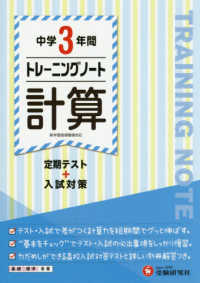Full Description
This open-access book surveys how digital technology can contribute effectively to improving our understanding of the past, through a sensory engagement based on the evidence of material culture. In particular, it encourages specialists to consider senses and human agency as important factors in studying ancient space, while recognising the role played by digital tools in enhancing a human-centred form of analysis. Significant advances in archaeological computing, digital methods, and sensory approaches have led archaeologists to rethink strategies and methods for creating narratives of the past. Recent progress in data visualisation and implementation, as well as other nascent digital sensory methods, means that it is now easier to explore and experience ancient space from a multiscalar perspective, from the individual body or single building to the wider landscape.
The chapters in Capturing the Senses: Digital Methods for Sensory Archaeologies present innovative methods for representing an embodied experience of ancient space, simulating (but not recreating) ancient behaviours and social interaction. Chapters cover topics including the potentials and pitfalls of visualising, recreating, and re-enacting/experiencing the senses in Virtual Reality environments and also digital reconstructions and auralisations of ancient spaces to study sound sensory perception. Overall, the book demonstrates that multisensory approaches can give a new perspective on how ancient spaces were intended to be used by inhabitants to fulfil a series of purposes including conveying messages and regulating movement.
This is an open-access book.
Contents
Preface.- Introduction (G.Landeschi and E. Betts).- More than Modal? exploring affect, affordance, invitation and solicitation (S. Eve and M. Gillings).- The Senses and the Sacred: a multisensory and digital approach to examining an Ancient Egyptian funerary landscape (E. Sullivan).- Kinesthetic Archaeologies: digital methods and the reconstruction of movement (S. Dunn).- Exploring Fragmented data: environments, people and the senses in Virtual Reality (C. Sciuto and A. Foka).-Combining 3D visibility analysis and virtual acoustics analysis for the architectural study of ancient theatres (C. Manzett).- 'Please, touch the exhibits': 3D archaeology for experiential spatialization (E. Bozia) Sailing along the coast of North Etruria: ancient perceptions vs multidisciplinary coastal landscape studies (M. Pasquinucci and G. Landeschi).- Multisensory Experiences in Archaeological Landscape: sound, vision, and movement in GIS and Virtual Reality. (H. Richards-Rissetto, K. E. Primeau, D. E.Witt, and G. Goodwin).- Home-making in 17th century Amsterdam: a 3D reconstruction to investigate visual cues in the entrance hall of Pieter de Graeff (1638-1707) (C. Piccoli).- The Embodied City: a method for multisensory mapping (A.Misharina and E. Betts).








